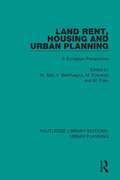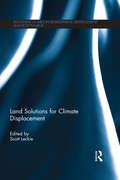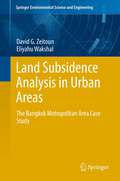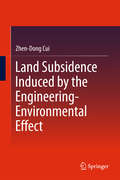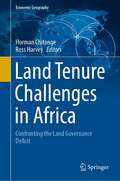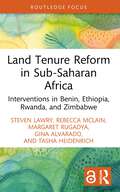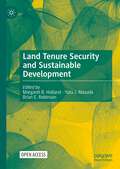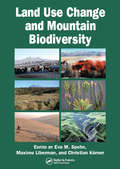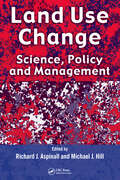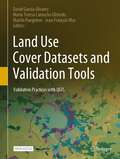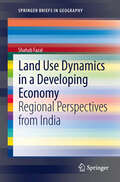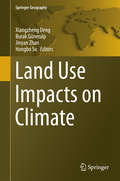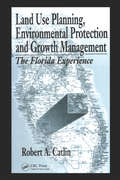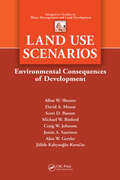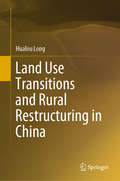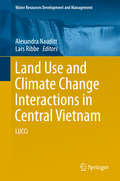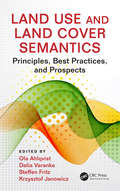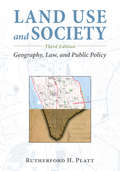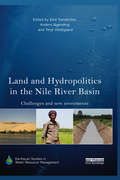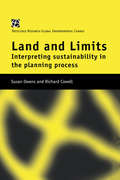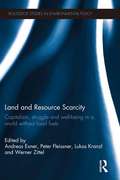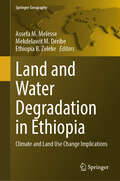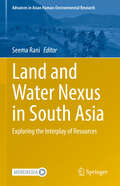- Table View
- List View
Land Rent, Housing and Urban Planning: A European Perspective (Routledge Library Editions: Urban Planning #3)
by M. Ball, V. Bentivegna, M. Edwards and M. FolinOriginally published in 1985, Land Rent, Housing and Urban Planning looks at the crucial social relationships associated with land ownership, and how these have played a crucial role in the economic development of many societies. The understanding of these relationships within modern capitalist societies has proved difficult. Land ownership relations emerge as requiring specific historical analysis for specific periods and societies and as being integral aspects of the capitalist mode of production as a whole – not merely mechanisms which redistribute some independently-determined surplus.
Land Solutions for Climate Displacement (Routledge Studies in Development, Displacement and Resettlement)
by Scott LeckieThe threat of climate displacement looms large over a growing number of countries. Based on the more than six years of work by Displacement Solutions in ten climate-affected countries, academic work on displacement and climate adaptation, and the country-level efforts of civil society groups in several frontline countries, this report explores the key contention that land will be at the core of any major strategy aimed at preventing and resolving climate displacement. This innovative and timely volume coordinated and edited by the Founder of Displacement Solutions, Scott Leckie, examines a range of legal, policy and practical issues relating to the role of land in actively addressing the displacement consequences of climate change. It reveals the inevitable truth that climate displacement is already underway and being tackled in countries such as Bangladesh, Kiribati, Papua New Guinea, Solomon Islands, Tuvalu and the United States, and proposes a series of possible land solution tools that can be employed to protect the rights of people and communities everywhere should they be forced to flee the places they call home.
Land Subsidence Analysis in Urban Areas
by David G. Zeitoun Eliyahu WakshalCities built on unconsolidated sediments consisting of clays, silt, peat, and sand, are particularly susceptible to subsidence. Such regions are common in delta areas, where rivers empty into the oceans, along flood plains adjacent to rivers, and in coastal marsh lands. Building cities in such areas aggravates the problem for several reasons: 1. Construction of buildings and streets adds weight to the region causing additional soil deformations. 2. Often the regions have to be drained in order to be occupied. This results in lowering of the water table and leads to hydro-compaction. 3. Often the groundwater is used as a source of water for both human consumption and industrial use. 4. Levees and dams are often built to prevent or control flooding. Earth fissures caused by ground failure in areas of uneven or differential compaction have damaged buildings, roads and highways, railroads, flood-control structures and sewer lines. As emphasized by Barends , "in order to develop a legal framework to claims and litigation, it is essential that direct and indirect causes of land subsidence effects can be quantified with sufficient accuracy from a technical and scientific point of view." Most existing methods and software applications treat the subsidence problem by analyzing one of the causes. This is due to the fact that the causes appear at different spatial scales. For example, over-pumping creates large scale subsidence, while building loading creates local subsidence/consolidation only. Then, maximum permissible land subsidence (or consolidation) is a constraint in different management problems such as: groundwater management, planning of town and/or laws on building construction. It is, therefore, necessary to quantify the contribution of each cause to soil subsidence of the ground surface in cities urban area. In this text book, we present an engineering approach based on the Biot system of equations to predict the soil settlement due to subsidence, resulting from different causes. Also we present a case study of The Bangkok Metropolitan Area (BMA).
Land Subsidence Induced by the Engineering-Environmental Effect
by Zhen-Dong CuiThis book brings forward the concept of the geology-environmental capacity of ground buildings. It quantifies the geology-environmental capacity of ground buildings by analyzing the main factors of land subsidence and setting up the evaluation system. The geological environmental capacity of ground buildings is mainly controlled by the land subsidence and the output is the floor area ratio. According to the different geology structures and the different requirements of subsidence control in the soft soil areas in Shanghai, the evaluation system of the floor area ratio is built up by the adaptive neuro-fuzzy inference system (ANFIS) and the floor area ratios of four typical regions (Lujiazui, Xujiahui, Zhongyuan and Changqiao) are obtained by the ANFIS to offer references for urban planning. By taking the typical soft soil areas in Shanghai as case studies, this book will provide valuable insights to professors and graduate students in the field of Geotechnical Engineering, Civil Engineering, Engineering Geology and Environmental Geology.
Land Tenure Challenges in Africa: Confronting the Land Governance Deficit (Economic Geography)
by Horman Chitonge Ross HarveyThis book provides a significant contribution to the literature on land reform in various African contexts. While the economic evidence is clear that secure property rights are a necessary condition for catalysing broad-based economic development, the governance process by which those rights are secured is less clear. This book details the historical complexity of land rights and the importance of understanding this history in the process of trying to improve tenure security. Through a combination of single country case studies, comparative case studies and regional comparisons, the book is unequivocal that good governance is paramount for improving the performance of land reform programmes. All attempts at moving towards more formal secure tenure require congruence with informal norms, beliefs and values, and a set of clear systems and processes to avoid corruption and unintended negative consequences.
Land Tenure Reform in Sub-Saharan Africa: Interventions in Benin, Ethiopia, Rwanda, and Zimbabwe (Routledge Focus on Environment and Sustainability)
by Steven Lawry Rebecca McLain Margaret Rugadya Gina Alvarado Tasha HeidenrichThis book examines the impacts of land tenure reform interventions implemented in Benin, Ethiopia, Rwanda, and Zimbabwe. Since 2000, many African countries have introduced programs aimed at providing smallholder farmers with low-cost certificates for land held under customary tenure. Yet there are many contending views and debates on the impact of these land policies and this book reveals how tenure security, agricultural productivity, and social inclusion were affected by the interventions. It analyses the results of carefully selected, authoritative studies on interventions in Benin, Ethiopia, Rwanda, and Zimbabwe and applies a realist synthesis methodology to explore the socio-political and economic contexts. Drawing on these results, the book argues that inadequate attention paid to the core characteristics of rural social systems obscures the benefits of customary tenure while overlooking the scope for reforms to reduce the gaps in social status among members of customary communities. This book will be of great interest to students and scholars of land management and use, land and property law, tenure security, agrarian studies, political economy, and sustainable development. It will also appeal to development professionals and policymakers involved in land governance and land policy in Africa.
Land Tenure Security and Sustainable Development
by Margaret B. Holland Yuta J. Masuda Brian E. RobinsonThis open access book presents a nuanced and accessible synthesis of the relationship between land tenure security and sustainable development. Contributing authors have collectively worked for decades on land tenure as connected with conservation and development across all major regions of the globe. The first section of this volume is intended as a standalone primer on land tenure security and its connections with sustainable development. The book then explores key thematic challenges that interact directly with land tenure security, followed by a section on strategies for addressing tenure insecurity. The book concludes with a section on new frontiers in research, policy, and action. An invaluable reference for researchers in the field and for practitioners looking for a comprehensive overview of this important topic.This is an open access book.
Land Under the Sea
by Joan Lowery Nixon Hershell H. NixonDescribes the exploration of the land beneath the sea and what it has revealed about the topography of this vast hidden area. Also discusses how these discoveries help us better understand the earth upon which we live.
Land Use Change and Mountain Biodiversity
by Eva M. Spehn Máximo Liberman Christian KornerPart of the worldwide biodiversity program DIVERSITAS, the Global Mountain Biodiversity Assessment (GMBA) assesses the biological richness of high-elevation biota. GMBA's focus includes the uppermost forest regions or their substitute rangeland vegetation, the treeline ecotone, and the alpine and nival belts. Providing more than description, the GM
Land Use Change: Science, Policy and Management
by Michael J. Hill Richard J. AspinallChanges in the use of land reflect a variety of environmental and social factors, necessitating an equally varied suite of data to be used for effective analysis. While remote sensing, both from satellites and air photos, provides a central resource for study, socio-economic surveys, censuses, and map sources also supply a wealth of valid informati
Land Use Cover Datasets and Validation Tools: Validation Practices with QGIS
by María Teresa Camacho Olmedo Martin Paegelow David García-Álvarez Jean François MasThis open access book represents a comprehensive review of available land-use cover data and techniques to validate and analyze this type of spatial information. The book provides the basic theory needed to understand the progress of LUCC mapping/modeling validation practice. It makes accessible to any interested user most of the research community's methods and techniques to validate LUC maps and models. Besides, this book is enriched with practical exercises to be applied with QGIS. The book includes a description of relevant global and supra-national LUC datasets currently available. Finally, the book provides the user with all the information required to manage and download these datasets.
Land Use Dynamics in a Developing Economy
by Shahab FazalToday, India still remains a rural agricultural country although the share of urban population has also increased but these figures do not tell the whole story. There are evidences that urban growth is dispersed and urban sprawl promotes the spread of urban land use into the rural-urban fringe. Here the attempt is to investigate the land transformation and the driving forces which were influencing the land transformation. The present study was done on peri urban interface of Aligarh city, a relatively small city, but as other north Indian cities, it is also expanding rapidly. Moreover, it too is surrounded by a populous rural area with productive and rich agricultural hinterland. Such conditions give rise to many conflicts and mutually beneficial complementarities in the rural and urban spheres. The result shows that the demand for land is high which results in informal urban development fulfilling the requirements of many of the city's residents. Every piece of land is a tradable commodity, and the pursuit of short-term profits is the predominant ethic. The actors in PUI are strong because it is characterized by intermixing of rural and urban activities and interests as well as the number of actors are greater than in any other area. .
Land Use Impacts on Climate
by Xiangzheng Deng Jinyan Zhan Burak Güneralp Hongbo SuThis book introduces a key issue in research on the climatic impact of land cover and land use changes via terrestrial biogeophysical processes. The parameterization of surface processes and a systematic approach to modeling the climatic impacts of land use change are discussed respectively, and can be used to improve parameterization schemes for climate numerical models and to provide a systematic method, thus offering more scientific and enhanced support for research on the climatic effects of land use/cover change. Further, based on predictions and scenario analyses of land use changes in typical zones, the climatic impact of various types of changes in different areas can be simulated through climatic numerical modeling, the simulation results are suitable for use in climate mitigation, land use planning, urban development planning, etc. Thus, the book is intended for researchers and professionals working in the area of meteorology systems, climatic numerical modeling, climate change, and land use/cover change, as well as decision makers in meteorology and land use planning. Professor Xiangzheng Deng is a senior research fellow at the Institute of Geographical Sciences and Natural Resources Research, Chinese Academy of Sciences.
Land Use Planning, Environmental Protection and Growth Management: The Florida Experience
by Robert A CatlinThis book examines the history and impact of Florida's Comprehensive Planning legislation. Topics include coastal zone management, solid waste planning, land use impacts, planning strategies, and more.
Land Use Scenarios: Environmental Consequences of Development (Integrative Studies in Water Management & Land Development)
by David A. Mouat Alan W. Shearer Scott D. Bassett Michael W. Binford Craig W. Johnson Justin A. Saarinen Alan W. Gertler Julide KoracinAny alteration of the natural processes occurring on a piece of land will have expected as well as unanticipated effects, and those effects have little regard for arbitrary human boundaries. Consequently, it is not enough for land managers to consider only how they might maintain the parcels for which they are responsible; they must also anticipate
Land Use Transitions and Rural Restructuring in China
by Hualou LongIntended as a comprehensive guide to the study of land use and rural development, this book offers detailed descriptions of land use transitions and rural restructuring. To do so, it chiefly focuses on three main aspects, the first of which is the application of geographical perspectives in order to understand rural issues in connection with urbanization, industrialization, globalization and rural vitalization strategies in contemporary China. Secondly, it presents a rich blend of regional and national analyses; detailed explorations of local cases; and critical and theoretically informed discussions that address historical paths and future projections. Lastly, it adapts concepts derived from western literature to situations and experiences in rural China, and provides empirical evidence from an “insider” perspective. Given its scope, the book offers a valuable resource for researchers, and for graduate students / courses in geography and sociology.
Land Use and Climate Change Interactions in Central Vietnam
by Alexandra Nauditt Lars RibbeThis book summarizes the key findings of a five-year interdisciplinary research project funded by the German Federal Ministry of Research and Education (BMBF). It serves as a typical case study for a rapidly growing and developing urban center - Da Nang City, which is surrounded by remote areas characterized by increasing migration and limited development. A number of German and Vietnamese universities and international institutions participated in the project, contributing their particular expertise to assess the data-scarce region under study, two provinces in central Vietnam with a combined area of ca. 12,000 km#65533;.
Land Use and Land Cover Semantics: Principles, Best Practices, and Prospects
by Steffen Fritz Ola Ahlqvist Krzysztof Janowicz Dalia VarankaExplore the Important Role that the Semantics of Land Use and Land Cover Plays within a Broader Environmental ContextFocused on the information semantics of land use and land cover (LULC) and providing a platform for reassessing this field, Land Use and Land Cover Semantics: Principles, Best Practices, and Prospects presents a comprehensive overview of fundamental theories and best practices for applying semantics in LULC. Developed by a team of experts bridging relevant areas related to the subject (LULC studies, ontology, semantic uncertainty, information science, and earth observation), this book encourages effective and critical uses of LULC data and considers practical contexts where LULC semantics can play a vital role.The book includes work on conceptual and technological semantic practices, including but not limited to categorization; the definition of criteria for sets and their members; metadata; documentation for data reuse; ontology logic restrictions; reasoning from text sources; and explicit semantic specifications, ontologies, vocabularies, and design patterns. It also includes use cases from applicable semantics in searches, LULC classification, spatial analysis and visualization, issues of Big Data, knowledge infrastructures and their organization, and integration of bottom-up and top-down approaches to collaboration frameworks and interdisciplinary challenges such as EarthCube. This book: Centers on the link between planning goals, objectives, and policy and land use classification systems Uses examples of maps and databases to draw attention to the problems of semantic integration of land use/cover data Discusses the principles used in a categorization Explores the origins and impacts of semantic variation using the example of land cover Examines how crowd science and human perceptions can be used to improve the quality of land cover datasets, and more Land Use and Land Cover Semantics: Principles, Best Practices, and Prospects offers an up-to-date account of land use/land cover semantics, looks into aspects of semantic data modeling, and discusses current approaches, ongoing developments, and future trends. The book provides guidance to anyone working with land use or land cover data, looking to harmonize categories, repurpose data, or otherwise develop or use LULC datasets.
Land Use and Society: Geography, Law, and Public Policy
by Rutherford H. PlattThe intersection between geography and law is a critical yet often overlooked element of land-use decisions, with a widespread impact on how societies use the land, water, and biodiversity around them. Land Use and Society, Third Edition is a clear and compelling guide to the role of law in shaping patterns of land use and environmental management. Originally published in 1996 and revised in 2004, this third edition has been updated with data from the 2010 U. S. Census and revised with the input of academics and professors to address the changing issues in land use, policy, and law today. Land Use and Society, Third Edition retains the historical approach of the original text while providing a more concise and topical survey of the evolution of urban land use regulation, from Europe in the Middle Ages through the present day United States. Rutherford Platt examines the "nuts and bolts" of land use decision-making in the present day and analyzes key players, including private landowners, local and national governments, and the courts. This third edition is enhanced by a discussion of the current trends and issues in land use, from urban renewal and demographic shifts in cities to the growing influence of local governance in land use management. Land Use and Society, Third Edition is a vital resource for any student seeking to understand the intersection between law, politics, and the natural world. While Platt examines specific rules, doctrines, and practices from an American context, an understanding of the role of law in shaping land use decisions will prove vital for students, policymakers, and land use managers around the world.
Land Use and the Carbon Cycle
by Daniel G. Brown Derek T. Robinson Nancy H. F. French Bradley C. ReedAs governments and institutions work to ameliorate the effects of anthropogenic CO2 emissions on global climate, there is an increasing need to understand how land-use and land-cover change is coupled to the carbon cycle, and how land management can be used to mitigate their effects. This book brings an interdisciplinary team of fifty-eight international researchers to share their novel approaches, concepts, theories and knowledge on land use and the carbon cycle. It discusses contemporary theories and approaches combined with state-of-the-art technologies. The central theme is that land use and land management are tightly integrated with the carbon cycle and it is necessary to study these processes as a single natural-human system to improve carbon accounting and mitigate climate change. The book is an invaluable resource for advanced students, researchers, land-use planners and policy makers in natural resources, geography, forestry, agricultural science, ecology, atmospheric science and environmental economics.
Land and Hydropolitics in the Nile River Basin: Challenges and new investments (Earthscan Studies in Water Resource Management)
by Terje Oestigaard Anders Jägerskog Emil SandströmThe Nile River Basin supports the livelihoods of millions of people in Egypt, Ethiopia, Sudan and Uganda, principally as water for agriculture and hydropower. The resource is the focus of much contested development, not only between upstream and downstream neighbours, but also from countries outside the region. This book investigates the water, land and energy nexus in the Nile Basin.It explains how the current surge in land and energy investments, both by foreign actors as well as domestic investors, affects already strained transboundary relations in the region and how investments are intertwined within wider contexts of Nile Basin history, politics and economy. Overall, the book presents a range of perspectives, drawing on political science, international relations theory, sociology, history and political ecology.
Land and Limits: Interpreting Sustainability in the Planning Process (Rtpi Library Ser.)
by Richard Cowell Susan OwensIn a new and critical analysis, this book explores the impact of an influential idea - sustainable development - on the institutions and practices governing use of land. It examines the paradox that in spite of increasing attention to sustainability, land use conflict is as ubiquitous and intense as ever.
Land and Resource Scarcity: Capitalism, Struggle and Well-being in a World without Fossil Fuels (Routledge Studies in Environmental Policy)
by Andreas Exner Lukas Kranzl Peter Fleissner Werner ZittelThis book brings together geological, biological, radical economic, technological, historical and social perspectives on peak oil and other scarce resources. The contributors to this volume argue that these scarcities will put an end to the capitalist system as we know it and alternatives must be created. The book combines natural science with emancipatory thinking, focusing on bottom up alternatives and social struggles to change the world by taking action. The volume introduces original contributions to the debates on peak oil, land grabbing and social alternatives, thus creating a synthesis to gain an overview of the multiple crises of our times. The book sets out to analyse how crises of energy, climate, metals, minerals and the soil relate to the global land grab which has accelerated greatly since 2008, as well as to examine the crisis of profit production and political legitimacy. Based on a theoretical understanding of the multiple crises and the effects of peak oil and other scarcities on capital accumulation, the contributors explore the social innovations that provide an alternative. Using the most up to date research on resource crises, this integrative and critical analysis brings together the issues with a radical perspective on possibilites for future change as well as a strong social economic and ethical dimesion. The book should be of interest to researchers and students of environmental policy, politics, sustainable development and natural resource management.
Land and Water Degradation in Ethiopia: Climate and Land Use Change Implications (Springer Geography)
by Assefa M. Melesse Mekdelawit M. Deribe Ethiopia B. ZelekeWater is life for all human beings and is essential for sustainable economic development. Access to freshwater is a fundamental human right. Ensuring access to safe drinking water and sanitation is vital for economic growth, poverty reduction and enhancement of human well-being. Yet, uncertain global water availability compounded by factors such as climate change and land degradation have made meeting the growing water demand a daunting task for many communities. The world is facing an unprecedented climate crisis, intricately linked with water resources. We have witnessed frequent and intense hydrologic extremes (floods and droughts). In the past decade alone, floods, storms, droughts, and other weather-related events accounted for over 90% of natural disasters. Water, being at the center of national policies of many countries, the impact of climate change on water resources extends across multiple sectors including energy production, food security, health, environmental conservation, and economic development. Research has shown that climate change has impacted the hydrologic cycle, affected the availability and predictability of water, and hence threatened the efforts of poverty reduction and economic development. These impacts are more pronounced in developing countries, exacerbating existing socioeconomic challenges, and hindering progress towards self-sufficiency in food, water, and energy production. The impact of climate change on these countries is further aggravated by land degradation, land use changes, unsustainable agricultural practices, poor watershed management and ecological degradation and loss of biodiversity. This book aims to explore these issues, with chapters dedicated to examining land and water degradation, water quality, irrigation, groundwater management, land use dynamics and the impacts of climate change on freshwater resources in Ethiopia.
Land and Water Nexus in South Asia: Exploring the Interplay of Resources (Advances in Asian Human-Environmental Research)
by Seema RaniThis book aims to unravel the intricate relationship between land and water resources and delve into their interdependencies, synergies, and challenges. As the world grapples with pressing issues such as water scarcity, land degradation, and climate change, understanding the complex dynamics and interplay between these two critical resources has become more crucial than ever. This comprehensive volume brings together multidisciplinary perspectives from leading experts in the field, offering an integrated approach to studying the land-water nexus. The book provides readers with a clear understanding of how land and water interact and delves into key topics such as land use change and its impacts on water resources, water management in agricultural landscapes, land-water interactions in aquatic ecosystems, urbanization and water resource management, and climate change's influence on the land-water nexus. Moreover, the book investigates integrated governance frameworks, policy considerations, and sustainable development approaches that are essential for effective land and water resource management. It also sheds light on future perspectives and research frontiers, envisioning innovative solutions to address emerging challenges in this field. By synthesizing current knowledge, showcasing case studies, and presenting cutting-edge research, this book provides a valuable resource for researchers, policymakers, and professionals working in water resource management, environmental science, agriculture, urban planning, and sustainable development. The book's holistic approach encourages readers to envision sustainable pathways that balance the needs of both land and water, fostering a resilient and harmonious future for our planet.
